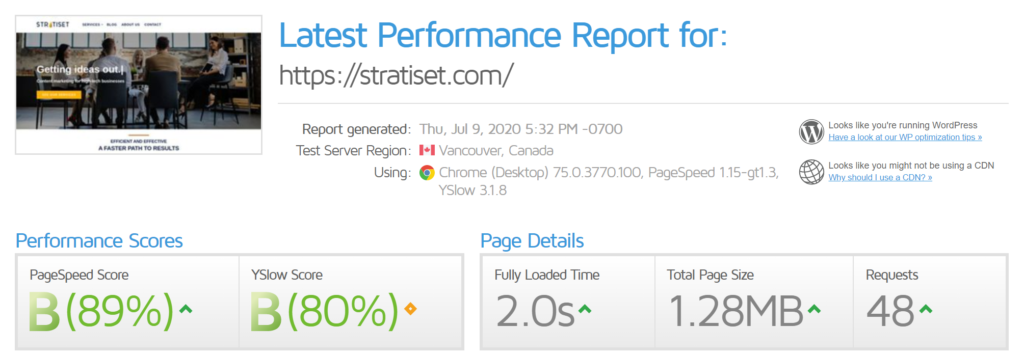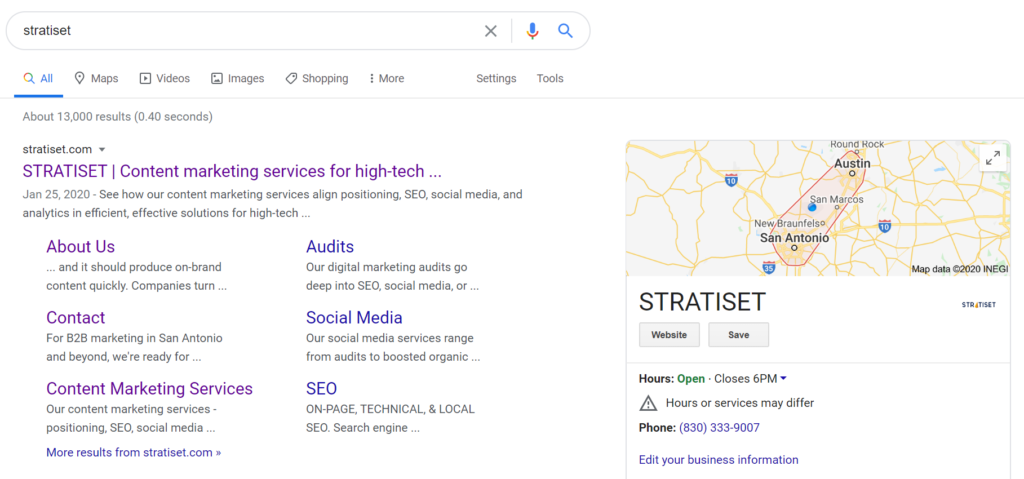We’ve all done it, Googling our own business in an idle moment to see how our website is doing. At launch, search engine optimization (SEO) was something you hoped would produce results. Now, months or years later, it might be unclear what SEO and content strategy accomplished. Often, SEO experts share monthly canned reports with lots of data but few insights about what is really going on with your site.
While there’s a place for advanced strategies, most SEO problems stem from inattention to details. Even SEO pros miss things sometimes, or it may have been a while since someone looked at site optimizations. To find out what’s working and what might be holding you back, you’ll need to talk with your in-house team or agency. Scary, because they’re super technical? Let’s prepare you for your next conversation with SEO and content strategy questions that will help you and your team get on the same page.
Rule out three common things first
Since you’re already self-Googling, here’s a little bit of self-service homework before you bring in your experts. It’s easy to spot or rule out some common rank killers.
First, if your site is a few years old, it may be insecure. Google has moved from merely suggesting https:// to preferring it, ranking secure sites higher than insecure ones. Type in your URL and see if a small lock icon appears left of the URL when the page loads. Even if you type in an http:// prefix, you should redirect to the https:// version.
If your site was recently modified, some pages may not be indexed. Google crawls sites looking for updated pages, but for sites with less traffic automated crawls may be days or weeks away after a new page goes live. If someone disallowed crawling while working on pages, and overlooked re-enabling it, the index won’t update. Search Google for your domain name using a site: prefix (for ours, site:stratiset.com). This returns all the pages for your site in the Google index. It also shows results just as your visitors see them. If pages are missing or the wording looks old, it’s a simple process for your team to request re-indexing.
Finally, don’t guess how fast your home page is, measure it, because speed affects ranking. Visit GTmetrix.com for a load time analysis. Desktop load times of 3 seconds and below are good; every tick past 4 loses potential visitors. One big speed bump is the image slider on many home pages – if you have one, ask your team if the images and scripts are optimized.

Summary:
• Is our site secure, with https:// access?
• Has our site recently been crawled and fully indexed?
• Does our home page consistently load in 3 seconds or less?
How is our home page doing?
With secure access, indexing, and speed issues covered, it’s time to ask your team what the home page is doing. It should tell your brand story, but it shouldn’t stand alone; it grabs and steers visitors into your site. Some SEO experts say home pages should not target one phrase, and ranking isn’t the goal. But a little optimization often produces results.
Why do competitors rank higher when you Google your favorite term? Ask your experts which competitor pages rank, and why. If it’s a home page, examine how they optimized for that term. Minor changes to your page title, description, the H1 heading, and first paragraph of text could impact your home page ranking.
Your competitors may have an interior page search result, making it tougher for your home page to compete – more on that later. Most home pages draw search impressions on many different terms but don’t rank well on most of them because those terms are only briefly mentioned. Ask if you’re getting impressions for the right terms for your business; if not, home page copy may need rewriting.
After a visitor arrives on your home page, what do they do next? Do they scroll down the page reading most of it, or leave when they see that large image and headline at the top? Are they clicking on your navigation and calls-to-action (CTAs)? Your experts can install a heat mapping tool to analyze user experience (UX) on the home page.
Summary:
• What must-have search term is optimized on the home page?
• How are high ranking competitor pages optimized for that term?
• What are the top 10 terms in search impressions on our home page?
• How does our home page UX look from a heat map?
How are our branded search results?
Branded search is how visitors look for your business, product/service, or key people. Customers often try to find your physical location or hours by looking for your brand. Perhaps they remember your brand but haven’t yet decided and are searching for more information. Branded search is where your home page should win, even over directories and company pages on social media. For example, here’s our business name search result.

The easiest way to win branded search is a unique, memorable brand name with consistent branding on social media. Is your business name mixed in with ones like it? Rebranding is expensive; try using a strong product/service name more.
Are sitelinks under your branded result? SEO is about width; the more pages you can draw attention to, the better. Presenting Google Search Console with an XML sitemap can help get more pages seen right away.
Also, setting up Google My Business is a quick way to improve rankings. While we have customers nationally, local SEO helps us compete with firms in and around San Antonio. Links in social media profiles also help.
Even if you get the top spot in organic search, someone can create a Google Ad with your brand name as a keyword and get a paid search result above yours. (Yes, that’s allowed, if their ad isn’t deceptive.) Paid ads can help cover both paid and organic branded search.
Follow-up summary:
• How can our branding help us win branded search?
• Do we have an XML sitemap entered in Google Search Console?
• How consistent are our Google My Business and social media profiles?
• Should we use Google Ads to thwart competitive paid branded search?
What’s our keyword strategy?
Asking a home page to do all the SEO work can lead to instability, where keyword rankings go up and down randomly. Want stable results within weeks? Dig into your keyword strategy, stronger interior pages, and internal linking.
If I could teach only one SEO concept, it’s this: Google wants one page per keyword.
Many sites cannibalize keywords, with two or more pages on the same keyword eating away each other’s results. More is not better; it splits Google’s attention. Which one is real? Which one is best? When Google can’t decide, they don’t – and your pages don’t show up as often.
Content pillars help prevent cannibalization and organize your pages for more impact.
Three elements make up a content pillar:
a head term like “mountain bikes,”
core topics like “mountain bike brakes” and “mountain bike handlebars,” and
subtopics in common questions like “what are the best mountain bike pedals?”
One page, even a great one, won’t win a head term with good traffic and strong competition. Instead, create new pages for long-tail terms with more words in the query, lowering traffic and competition. A laser-focused page on a subtopic matches a visitor’s search intent by answering their question. Subtopic pages should link to one core topic page, increasing its authority. Linked subtopic and core topic pages draw impressions, win clicks, and lift home page authority.
Follow-up summary:
• Are we sure we’re not cannibalizing keywords across more than one page?
• How are our content pillars organized, with head terms, core topics, and subtopics?
• What long-tail terms would be good targets for creating new subtopic pages?
What’s our backlink strategy?
You’ve heard about backlinks, where other sites link to pages in your site. In days gone by, some SEO agencies focused on backlinks in poorly written blurbs on link farms. Google caught on, and now penalizes rankings for links from toxic sites. Authentic backlinks are still important.
There are three basic backlinking strategies:
1. Apply to industry directories, or exchange links with sites sharing your audience,
2. Create externally-hosted content such as webinars, podcasts, and guest blog posts,
3. Develop quality content on your site and share it via your social media channels.
Directories and referrer sites can help site authority, important for newer or low-traffic sites. Quality industry directories may charge a fee for your listing or may offer a free tier for a link back to their site.
Aggregators get traffic using externally-hosted content from many contributors and a larger audience. Views of your content on these sites adds to your brand awareness.
But there’s a catch. You’re renting space on directories and aggregators – they could disappear at any time leaving you to start over. You own your site; you decide what content goes on it and how it is promoted.
The best approach to getting backlinks is helping visitors discover your content on social media – and when it’s useful, they’ll share it and link to it. Visitors coming from social media typically view more pages per session. Boosting social media posts that perform well organically can drive more views with a small budget.
Follow-up summary:
• What industry directories are we listed in?
• Should we be guest blogging, or guesting on podcasts or webinars?
• What are our social media visitor trends? Should we boost more social content?
How are we aligned with intent?
Until now, we’ve been talking about site authority and ranking. Time for the spoiler.
Let’s not forget: ranking is literally never the ultimate goal. Never. It’s what ranking makes possible for the company (a sale, a lead, a follower).
Ranking is just the mechanism. Showing up is not the endgame. #SEMrushChat
— Joel Klettke (@JoelKlettke) May 13, 2020
Satisfying search intent is the endgame. If Google senses people find what they want on your site when they search, your site appears to more people. Your SEO and content strategy should be about building that momentum at every step.
Exactly how Google does this is their science. We talked about https:// secure access and faster page load times. Other indicators are bounce rate, time on page, and pages per session. Experts say these aren’t ranking factors, but they often point to problems in satisfying intent.
A bounce is when a visitor enters your site and leaves without going to another page. As bounce rates lower, pages per session improve. A high bounce rate on a home page or a key landing page, where visitors should act, is a sign of trouble. A high bounce rate on your blog posts might be OK, if the reader found the answer they wanted. More time on page is good but be careful: Google Analytics records zero time on the page a visitor exits, and averages that in.
If your site has been up for six months or more, you’ve got data. Your team can see site analytics and heat mapping data and look for pages people find dissatisfying. When they identify those pages, play customer and read them out loud. Do they address your questions about the search term they target? Would you click on your CTAs, or go to another page? If not, there’s work to do.
Follow-up summary:
• What is the bounce rate on our home page and key landing pages?
• How do our home page and key landing pages sound when read?
• What pages are candidates for rewriting or redesign to better match intent?
Getting more from SEO and content strategy
You and your team can learn a lot exploring these questions on your SEO and content strategy. At the least, easily fixed details may come to light and get resolved quickly. A better outcome would be a plan for improving your search intent match with new or modified content.
It’s my belief positioning, SEO, social media, and content writing are connected in content strategy loops. Getting more from SEO means looking at the entire content strategy. I’m always happy to you and your in-house marketing team a second opinion or join you as an observer on your call with an external agency. An SEO audit with actionable findings might also help speed things up.
Isn’t this better than self-Googling? Let me know how this conversation improved your SEO – send me a note on social media or use our Contact page.

